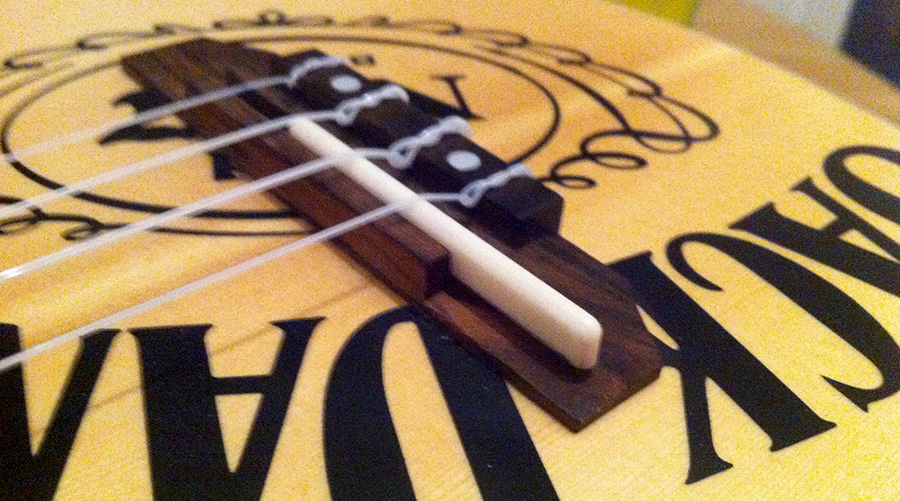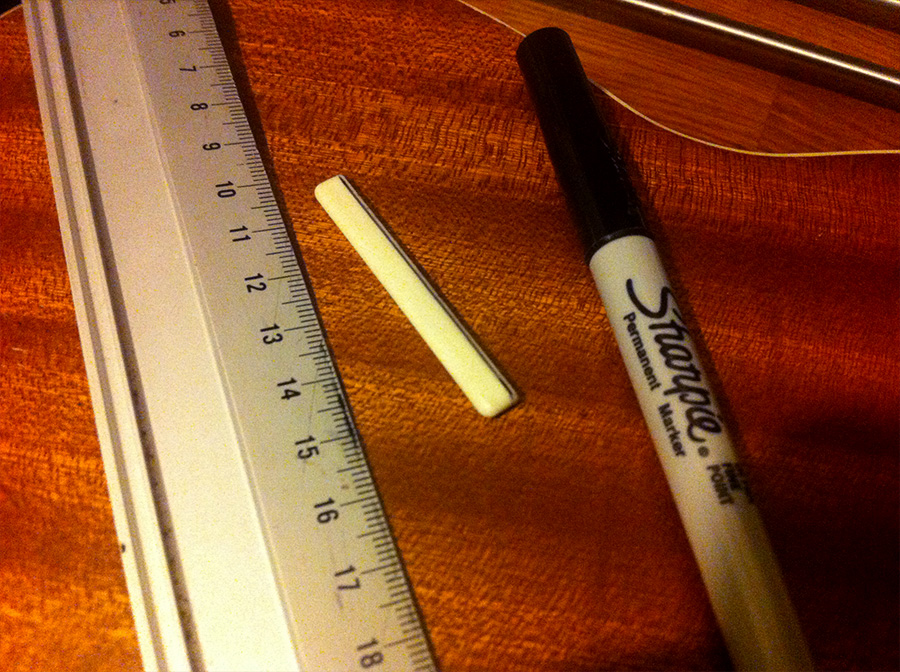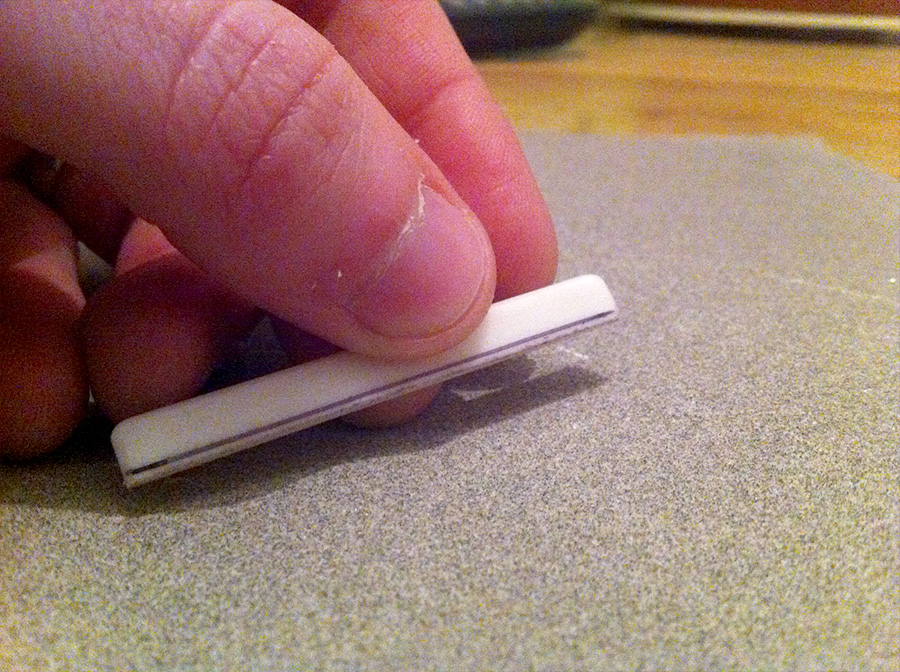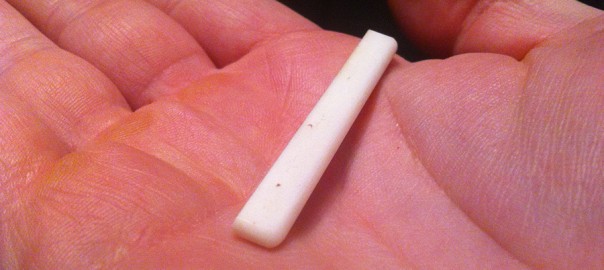I’ve been watching loads of videos on setting up a ukulele recently and I thought I’d have a go at lowering the action on my Peavey concert ukulele. Here’s how I did it…
What’s the action?
The action on a ukulele is effectively the gap between the strings and the fretboard. Typically at the nut end the action will be quite low but the further you get up the neck it will be higher and this is where it really starts to affect your playing. If the strings are too high from the fretboard it will be difficult to play. If they’re too close then you may get some buzzing.
Step 1 – Measure the action
The first step I took was to measure the action on my ukulele. I did this by taking a metal ruler and measuring the gap between the top of the 12th fret and the strings above it. Actually this is more difficult than it sounds as all the rulers I own have a slight overlap before the measurements start of around 3mm or so. That said, I could tell the action was too high on my ukulele just by the feel of it (and also just by comparing it to my other ukuleles).
Step 2 – Remove the saddle
The next step I took was to take the saddle off the ukulele. The saddle is held in place by the strings, so simply by loosening the strings with the tuners the saddle will slide out nice and easy. And it did.

Step 3 – Put a marker on the saddle
With the saddle removed I then put a marker on it 1mm from the bottom. I used a fine line sharpie and the steel ruler that I’d measured the action with. I thought this would make a nice visible guide and stop me from sanding off too much and ending up with a buzzing ukulele.

Step 4 – Get sanding/filing
It’s time to get filing! I had a piece of fine sandpaper that I thought would do the job. I put the sandpaper on a flat surface and then tried to hold the saddle with even pressure whilst I sanded it down. This was actually tougher than I expected. There’s not a lot to grip on a saddle and even though I felt like I was keeping it pretty flat, that turned out to not be the case and I had to make some slight adjustments to even it out.
I found it worked much better using big long movements rather than a short back and forth motion to sand the saddle down.

Step 5 – Slide the saddle back into place and tighten strings
With your newly adjusted saddle you can simply slide it back into place on your bridge and tighten your strings back up. Now it’s time to get your ukulele back in tune. The strings will take a lot of tightening to get back to the right pitch. This is the step that took me the longest which tells you just how fast and easy the whole process is.
So there it is, a much simpler process than I anticipated and I successfully managed to lower the action on my ukulele with losing a finger or breaking my uke. Who’d have thought? I actually think I could afford to go a little bit further with my saddle and will probably repeat the above steps at some point to lower the action a little more.
If anyone has any tips on keeping the saddle flat whilst sanding I’d love to hear them!





Good description of lowering the action. I wonder though if this would have the effect of also lowering the strings in the strumming area and cause the strumming hand to brush against the body.
Hi Richard, I think you’d have to be going pretty low (too low) with the saddle for that to happen and other problems like buzzing would probably arise before that became a problem anyway.
Why not file groves where each string touch the saddle ?
I’ll be honest with you Bob, I’ve never heard of anyone doing that and I can sort of see why. I’m guessing it would be pretty tricky to match all the grooves up and there’s no real reason to do it. There are some ukuleles that do have slotted saddles but they’re pretty rare. The Lanikai Tuna Uke that I reviewed actually had individual saddles like an electric guitar although I don’t believe they were also slotted.
I just thought it might be easier than filing or sanding the whole saddle down and it’s easier to see how much you’re dropping each string
The main reason for not doing that Bob is that it makes it very hard to keep the break angle right on the top of the saddle. That point is essential for accurate scale length. Much easier to sand the base and leave the top alone.
This an old comment (more than 6 months old) I didn’t sand the bottom of the action , I filed each groove on the top of the action equally and it’s been working great ! Much easier to get the barred chords with out buzzing. I don’t know why when building the uke they couldn’t be a little more precise! I did put a new set of better strings on while I had it apart.
I could have gone more but didn’t want to take the chance of strings buzzing.
I think it would be unwise to file individual slots in the saddle, unless you really know what you’re doing. You might well leave the action different for different strings, and there is a danger that you might be left with sharp edges that could damage the strings, causing them to snap. You might also get buzzing if the string moves even slightly in the groove you’ve cut. In the end, I think that it’s going to be easier to file the underneath of the saddle, as described above, even if it means having to do it two or three times until the desired action is achieved.
I think you’re absolutely right, it would just end up being more work.
I filed the bottom of the saddle and notched the top. I sanded the notches after filing. I dropped the action about 1/8″, and put on new strings. Working great ! Less power needed and no buzzing !
Glad to hear it worked for you Bob!
You’re a braver man than I am!
I bought my uke last week and found that when practicing I was often touching the C string when pressing the G string. This caused the C string to flub when strumming.
The string at the 1st fret is just one mm away from the fret.
Can some experienced uke player please tell me if this too much?
Should I go back to the shop and ask them if they will do the adjustment?
I want to lower the action on my uke, but don’t want to mar the instrument. It’s a 1962 Gibson Concert Ukulele (mahogany). The saddle is stuck. I can’t get it loose. Won’t budge. Any remedies for loosening it.
Many thanks,
Ken
When measuring the action at the 12th fret, what is optional height? Say the action at the 12th is 2mm to high, do we sand off 2mm off the nut?
Sorry, I meant saddle not nut.
REGARDING “The saddle is stuck.” Eventhough I’m NOT a woodworker, my guess is that unless an unknowing person put glue in the slot, the slot is simply gunked up and some solvent would loosen the saddle. I’d try judiciously applied hot water. If that didn’t work, I’d try WD40. If that didn’t work, I’d try Winsor Newton Brush Cleaner which can remove hardened “varnishes”. If that didn’t work, I’d try daily applying a solvent like the WD40 and let it soak in. I might try “vibrating” the saddle with a vibrator or even an electric toothbrush. I’d try end-tapping the saddle with a light hammer and a block of wood. I’d try grabbing the saddle with a pair of pliers and jiggling it back and forth and up and down. I’d try getting a tiny, small wedge like a shim, or a flattened nail, and tap it in under the saddle. (Make certain all your strings are removed.) Go slowly. Be cautious. If the saddle is glued in you have a problem. I’d try repeatedly cutting in with a razor blade on both sides of the saddle hoping to severe the glue’s connection points. Good luck.
Thank you for that whole host of possible solutions to unstick the saddle. I’ll start at the top of the list.
Many thanks,
Ken Kelly
P.S. If I get it loose, I’ll reply to you. 🙂
Thank you Phillip J Wagner – success
I let saddle seep in DW40 for 8 hours, easily removed saddle with pliers. Now to carefully sand it down, just a bit.
Again thanks,
Ken Kelly
i’m a newcome to ukulele and i was thinking in lowering the action.
The thing is that it is very hard to press the first fret of any string, is this normal in every ukulele or can it be fixed ¿?
Thanks.
To get the optimum action at the first fret, press the string at the 3rd fret and the string should just clear the first fret by about the thickness of a piece of paper. File the nut down carefully until it is. The gap may need to increase slightly for a low g string.
If anybody’s still around who knows… Does this mean to press right on the third metal thread, or next to/below it?
Depending on the value of the instrument and your level of confidence you might want to take the ukulele to a professional repair person for adjusting the nut. Have a look at several YouTube videos before doing anything. It might mean removing the nut, which is glued in place, unlike the bridge.
Does it affect the intonation? I guess it does, but maybe it’s barely noticable
to keep the bottom of a saddle perpendicular to the sides.
glue your 240 grit paper to a flat surface about 2inches wide 6 inches long.
make a fence 6 inches long 1 inch wide and 1/8 inch thick.
clamp on to top of the 240 grit . hold side of saddle against the fence as your
stroke the saddle back and forth on the grit. WORK SLOWLY AND DELIBERATE
LY ON EACH STROKE. SLOW IS QUICKER ON THIS TYPE OF WORK.
Great tips and ideas on bridge adjustment. Thanx, learned and saved a lot.
More than welcome Len
Just to say that to overcome the issue with metal rulers that “have a slight overlap before the measurements start”, I instead use e.g. an index card, place it on the top of the fret, mark the card in pencil just above the string, and measure the distance from card edge to pencil mark.
I’ve also read that for every 1mm you need to lower on a measurement taken at fret 12 you need to lower the saddle more like 2mm. Is that accurate across all ukulele types (soprano, tenor, etc.)?
Thanks again for the great article!
Because the bridge/saddle is twice as far from the nut as the 12th fret, lower the saddle exactly 2mm for each 1mm you want to lower the action at the 12th fret. But, best to check the nut slots first using the method somebody already explained above [third fret/sheet of paper etc.]. Then checking action at 12th fret and sanding down saddle will work. Do not slot the saddle, sand the bottom only! I do not know what the correct 12th fret action height should be, but it depends on and is proportional to the scale length. LOOK THAT UP BEFORE YOU PROCEED.
The import store that made my ukulele wasn’t thinking when they designed it, so the saddle is basically permanently glued down onto the uke. How do I fix this problem?
I did this exact same adjustment on a friend’s cheaper acoustic guitar not knowing it was an actual technique for lowering action. Now the guitar plays great. I did have to make a truss rod adjustment to straighten the neck. I think I could go just a hair lower with the bridge though, but it’s fine for now. I’m wanting to purchase a ukulele for my mother and teach her to play, and I want the action low so it’ll be easier for her fret. Thank you so much for posting this!
Ive noticed many ukuleles with fingerboards that point to the base of the bridge when viewed from the tuning end. This creates great gaps between the strings and the frets as one moves towards the high octave. It seems it should point to the base of the saddle as found in well made guitars. Such great gaps cannot be compensated by taking down the saddle. Is there a reason they are made this way? Seems faulty. I have a baritone whose fretboard comes very close to aligning with the sabble bottom. Plays well. Whatdyall think?